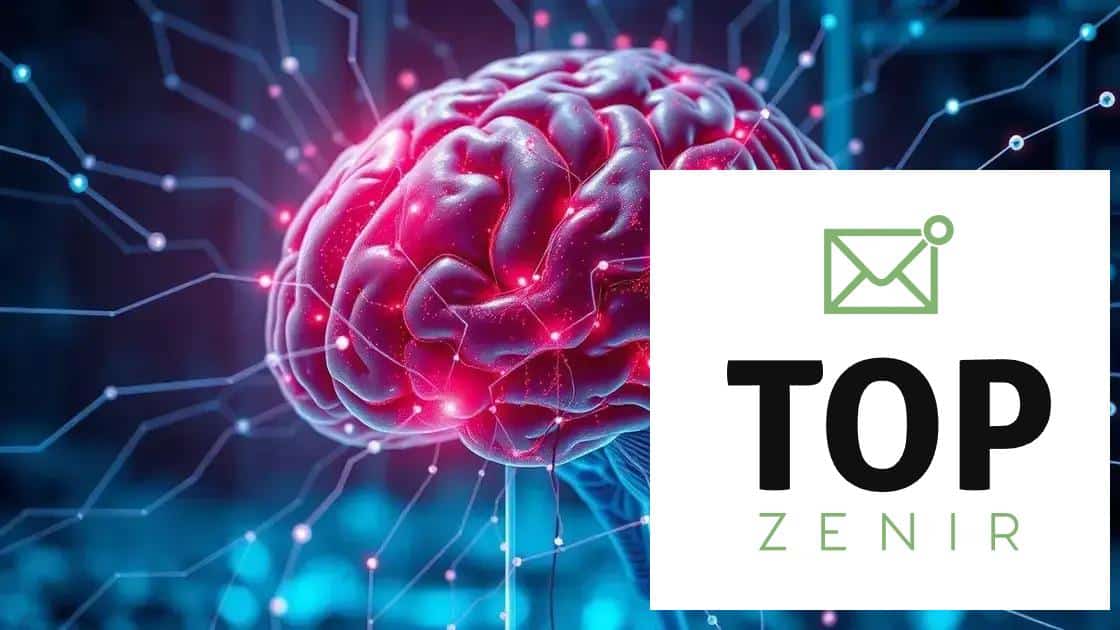Tech innovations enhance neural interface potential

Tech innovations enhance neural interface potential by enabling direct brain communication with devices, improving applications in healthcare, education, and entertainment, while addressing ethical and technical challenges.
Tech innovations enhance neural interface potential like never before, sparking curiosity about how these advancements might change our interactions with technology. Have you ever wondered how the brain could communicate directly with machines? Let’s dive into this fascinating topic.
Understanding neural interfaces and their significance
Understanding neural interfaces is essential as they redefine how we connect with technology. These systems allow the brain to communicate directly with external devices. This opens a world of possibilities, from controlling prosthetics to enhancing virtual reality experiences.
Importance of Neural Interfaces
Neural interfaces are significant for various reasons. They not only enhance communication but also improve quality of life for individuals with disabilities. These innovations bridge the gap between human cognition and machine learning, creating a powerful synergy.
- Enables direct brain communication with devices.
- Improves the capabilities of assistive technologies.
- Facilitates advancements in brain-computer interface research.
Moreover, the significance of these interfaces extends to areas like education and gaming. Imagine how neural interfaces can provide immersive learning experiences or revolutionize gameplay by allowing players to interact using their thoughts. As research progresses, we can expect more innovative applications.
Applications Across Fields
Neural interfaces find applications across diverse fields. Their role in medical science is particularly noteworthy. For instance, they assist in restoring movement to individuals with spinal cord injuries. By translating thoughts into commands for movement, technology is helping many regain independence.
- Used in rehabilitation for stroke patients.
- Offers new ways to control devices for those with mobility impairments.
- Enhances cognitive research in understanding brain functionality.
In addition to health care, neural interfaces are being explored in entertainment. They make possible experiences that seem like science fiction. People can interact with games and virtual worlds as if they were directly manipulating them with their minds. This fusion of human capability and technology leads to a thrilling future.
Overall, grasping the fundamentals of neural interfaces fosters a better understanding of their potential. These connections between the human brain and technology signify a leap toward innovative advancements that could transform our daily lives. Already, we see how these innovations enhance accessibility and entertainment, showcasing their growing importance in society.
Latest tech innovations in neural interface development

The field of neural interface technology is rapidly evolving. Recent innovations are pushing the boundaries of what was once thought possible. By integrating advanced technologies, we can now explore new applications that directly impact our daily lives.
Breakthroughs in Neural Interface Technology
One of the most exciting breakthroughs in neural interface development is the use of wireless functionality. This allows devices to communicate without physical connections. As a result, this technology becomes less invasive and more efficient.
- Wireless neural sensors improve user experience.
- Reduction of surgical risks with non-invasive methods.
- Enhanced data transfer rates for better performance.
Additionally, the advent of machine learning techniques is transforming how these devices interpret brain signals. This advancement enables devices to adapt and learn from user behavior, improving efficiency and personalization.
Real-World Applications
These innovations have real-world applications in fields like medicine and entertainment. For instance, brain-computer interfaces can now help with rehabilitation after strokes, allowing patients to regain mobility. Moreover, gaming companies are exploring this technology to create more immersive experiences where players can control games through thoughts alone.
- Medical devices restoring motor functions.
- Gaming experiences enhanced through brain activity.
- Improving communication aids for individuals with disabilities.
As research continues, we can expect more innovations that further integrate neural interfaces into our everyday lives. The future looks promising, with possibilities that extend beyond our current imagination, paving the way for smarter and more intuitive interactions with technology.
Applications of neural interfaces in various fields
Applications of neural interfaces span numerous fields, showcasing their versatility and impact on society. These technologies enable communication between the brain and devices, opening doors to groundbreaking possibilities in healthcare, education, and entertainment.
Medical Applications
In the medical field, neural interfaces are transforming patient care. They assist individuals with paralysis by allowing them to control prosthetic limbs through thought alone. This innovation greatly enhances their independence and quality of life.
- Assistive devices for people with mobility impairments.
- Neural interfaces to restore sensory functions.
- Brain-computer interfaces for rehabilitation therapy.
Moreover, they are used in deep brain stimulation, providing relief for patients suffering from conditions like Parkinson’s disease. This technique uses electrical impulses to modulate abnormal brain activity, improving motor function.
Education and Training
Educational institutions are also beginning to implement neural interface technology. These systems can analyze student engagement and focus levels, shaping the way educators deliver lessons. By understanding how students interact with material, teaching methods can be adapted for better learning outcomes.
- Improved focus tracking for personalized learning experiences.
- Enhanced virtual reality training environments for skill acquisition.
- Support for special education through tailored technology applications.
Furthermore, the technology holds promise in training simulations. For example, pilots or surgeons can practice critical skills in a safe virtual environment, enhancing their readiness for real-world scenarios.
Entertainment Innovations
The entertainment industry is not left behind; neural interfaces create immersive gaming experiences. Players can interact with games using their thoughts, leading to a more engaging and personalized experience. This could potentially change the way we perceive gaming forever.
- Games controlled by thought for immersive experiences.
- Interactive storytelling based on user brain activity.
- Virtual reality interactions that adapt to player emotions.
As these applications expand, we can expect neural interfaces to become a staple in various aspects of life. Their integration into different fields highlights the potential for these technologies to improve human experiences in remarkable ways.
Challenges and limitations faced by neural interface technology
Neural interface technology offers great promise, but it also faces various challenges and limitations that need to be addressed. These obstacles can hinder the potential advancements in this field, making it crucial to understand them.
Technical Challenges
One significant challenge is the complexity of interpreting brain signals accurately. Neural interfaces rely on sophisticated algorithms to decode neural activity. However, the brain’s signals are often noisy and difficult to interpret, which can lead to inaccuracies in device performance.
- Difficulty in achieving precise signal resolution.
- Need for advanced noise filtering techniques.
- Limitations in processing speed for real-time applications.
Additionally, the integration of these devices into existing systems can pose a technical hurdle. Ensuring compatibility with various platforms and technologies is vital for broader adoption. This includes making devices seamless and user-friendly.
Ethical and Social Concerns
Alongside technical challenges, neural interfaces raise ethical and social questions. One concern is privacy. As devices collect more data about our thoughts and behaviors, the potential for misuse increases. Protecting personal information becomes critical as we adopt these technologies.
- Concerns over data security and privacy.
- Potential for mind-reading implications in society.
- Need for regulations governing the use of neural data.
Furthermore, there is the risk of unequal access to these advancements. If only certain groups can afford or access neural interfaces, it could widen the gap between different segments of society. Ensuring equitable distribution is essential for public acceptance.
Biological Limitations
On a biological level, the long-term effects of using neural interface technology are not fully understood. For instance, how will implanted devices affect brain tissue over time? These uncertainties can complicate the development and approval of new devices.
- Questions about tissue biocompatibility.
- Concerns over chronic inflammation or damage.
- Need for extensive clinical trials to ensure safety.
Addressing these challenges will be vital for the continued evolution of neural interface technology. By understanding these limitations, researchers and developers can work toward solutions that will enhance the capabilities and acceptance of these innovative devices.
Future trends in neural interface innovations
The future of neural interface technology holds exciting trends and advancements that could change our interaction with both machines and one another. Researchers and developers are continually pushing the boundaries to enhance the functionality and accessibility of these devices.
Advancements in Brain-Computer Interfaces
One significant trend is the development of more intuitive brain-computer interfaces. These interfaces aim to provide a seamless connection between the brain and machines, allowing for smoother communication. Innovations in artificial intelligence (AI) are at the forefront of this progress.
- Improved signal decoding methods will enhance interpretation of neural data.
- AI algorithms could personalize user experiences by learning user preferences.
- Integration with virtual and augmented reality is expected to create immersive environments.
As these technologies evolve, users may find that interacting with devices becomes as natural as speaking or moving.
Healthcare Applications
In healthcare, the impact of neural interfaces will likely expand dramatically. Devices may help in the treatment of neurological disorders, offering new therapies for conditions such as epilepsy or chronic pain. By targeting specific brain areas, these interfaces could deliver therapeutic impulses, providing relief without invasive procedures.
- Neural interfaces as tools for mental health therapy.
- Enhanced rehabilitation techniques using real-time feedback.
- Wireless devices for remote monitoring and diagnosis.
Such applications highlight the potential for personalized medicine, paving the way for targeted treatments tailored to individual patient needs.
Ethical Considerations
As the technology progresses, ethical concerns surrounding neural interfaces will also become more significant. Questions about privacy, consent, and accessibility will need careful consideration. Regulations may evolve to ensure that these devices are used responsibly and that individuals’ rights are protected.
- Establishing guidelines for the ethical use of neural data.
- Ensuring equitable access to innovative technologies.
- Protecting consumer data from misuse and breaches.
Adaptation to these ethical dynamics will be crucial to gaining public trust and ensuring a beneficial integration of neural interfaces into society.
Potential for Direct Brain Communication
Another futuristic trend is the possibility of direct brain-to-brain communication. Such advancements could revolutionize how people connect and share thoughts, creating a more profound understanding among individuals. Imagine a world where we can share ideas and emotions instantly and without barriers.
- Research into collaborative environments using shared neural networks.
- Utilizing interfaces for enhanced empathy and communication.
- Creating new avenues for creativity through collective thought.
This possibility, while still theoretical, showcases the immense potential of neural interfaces as a catalyst for social change.
FAQ – Frequently Asked Questions about Neural Interfaces
What are neural interfaces?
Neural interfaces are technologies that enable direct communication between the brain and external devices, facilitating thought control over machines.
What are the main applications of neural interfaces?
The main applications include healthcare for assistive devices, education for personalized learning, and entertainment for immersive gaming experiences.
What challenges do neural interfaces face?
Challenges include technical issues like signal interpretation, ethical concerns regarding privacy, and biological effects on brain tissue.
What is the future potential of neural interfaces?
The future holds promise for advancements in brain-computer interfaces, personalized medicine, and possibly direct brain-to-brain communication.





